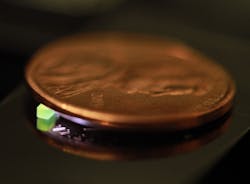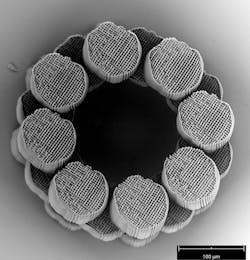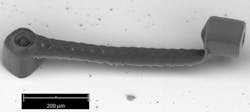Engineers at the Georgia Institute of Technology have developed a nanoscale 3D printing technique that fabricates small structures a thousand times faster than two-photon lithography (TPL) techniques, the conventional method of making nanoscale components. The new parallelized technique, known as femtosecond projection TPL (FP-TPL), can make parts with depth resolutions of 175 nanometers, which is better than established methods, and can fabricate structures with 90-deg. overhangs that can’t currently be made.
The technique could lead to manufacturing-scale production of bioscaffolds, flexible electronics, electrochemical interfaces, micro-optics, mechanical and optical metamaterials, and other functional micro- and nanostructures.
Existing nanoscale 3D printing techniques use a single spot of high-intensity light, typically around 700 to 800 nanometers in diameter, to convert photopolymer materials from liquids to solids. The point of light must scan through the entire structure being fabricated, so current TPL techniques often require many hours to build complex 3D structures. This limits its ability to be scaled up for practical applications.
A millimeter-scale structure with submicron features is supported on a U.S. penny on top of a reflective surface.
In the new process, a million points of light are projected simultaneously. This scales up the process because instead of working with a single point that has to be scanned to create the structure, it uses an entire plane of projected light that can be patterned into arbitrary structures.
To create a million points, the researchers use a digital mask similar to those used in projectors to create images and videos. In this case, the mask controls a femtosecond laser that creates the desired light pattern in the precursor liquid polymer material. The high-intensity light causes a polymerization reaction that turns the liquid to solid, where desired, to create 3D structures.
Each layer of the fabricated structure is formed by a 35-femtosecond burst of high-intensity light. The projector and mask then create layer after layer until the entire structure is produced. Removing the liquid polymer leaves behind the part. The FP-TPL technique lets researchers turn out a structure in eight minutes that would take several hours using conventional processes.
A stacked 3D ring structure is built by overlapping several projections in 3D space. Arbitrarily complex 3D structures can be generated through this depth-resolved nanoscale 3D printing technique.
“The new parallel method is a breakthrough in nanoscale printing that will open the door to using the remarkable performance in materials and structures at nanoscale in usable and affordable components,” says Lawrence Livermore National Lab’s Center for Engineered Materials and Manufacturing Director Chris Spadaccini.
Unlike 3D printing that uses particles sprayed onto a surface, the new technique goes deep into the liquid precursor, fabricating structures that could not be made with surface fabrication alone. For instance, the technique can produce what the researchers call an “impossible bridge” with 90-deg. overhangs and more than a 1,000:1 aspect ratio of length to feature size. “We can project the light to any depth we want in the material, so we can make suspended 3D structures,” says Spadaccini.
Researchers have printed suspended structures a millimeter long between bases that are smaller than 100 microns by 100 microns. The structure doesn’t collapse while being printed, no supports are needed because the liquid and solid are about the same density, and production happens so quickly the liquid doesn’t have time to be disturbed.
Beyond bridges, researchers also made a variety of structures that demonstrate the technique, including micro-pillars, cuboids, log-piles, wires, and spirals. The researchers used conventional polymer precursors, but Georgia Tech Assistant Professor Sourabh Saha believes the technique would also work for metals and ceramics that can be generated from precursor polymers.
“The real application for this would be in industrial-scale production of small devices that may be added to larger products, such as components in smartphones,” he says. “The next step is print with other materials to expand the material palette.”
Overhanging 3D structures printed by stitching several 2D projections demonstrate the 3D printing process’ ability to create depth-resolved features. The bridge structure, with 90 deg. overhangs, is challenging to print using serial scanning TPL techniques.
Research groups have been working for years to accelerate the two-photon lithography process used to print nanoscale 3D structures. The success of this group came from adopting a different way of focusing the light, using its time-domain properties, which allowed production of thin light sheets capable of high resolutions and tiny features.
Using a femtosecond laser let the team maintain enough light intensity to trigger two-photon polymerization while keeping point sizes thin. In the FP-TPL technique, femtosecond pulses are stretched and compressed as they pass through the optics to implement temporal focusing. The process, which generates 3D features smaller than the diffraction-limited focused light spot, requires that two photons hit the liquid precursor molecules simultaneously.
“Traditionally, there are tradeoffs between speed and resolution,” Saha says. “If you want a faster process, you lose resolution. We have broken this engineering tradeoff, letting us print a thousand times faster with the smallest of features.”




